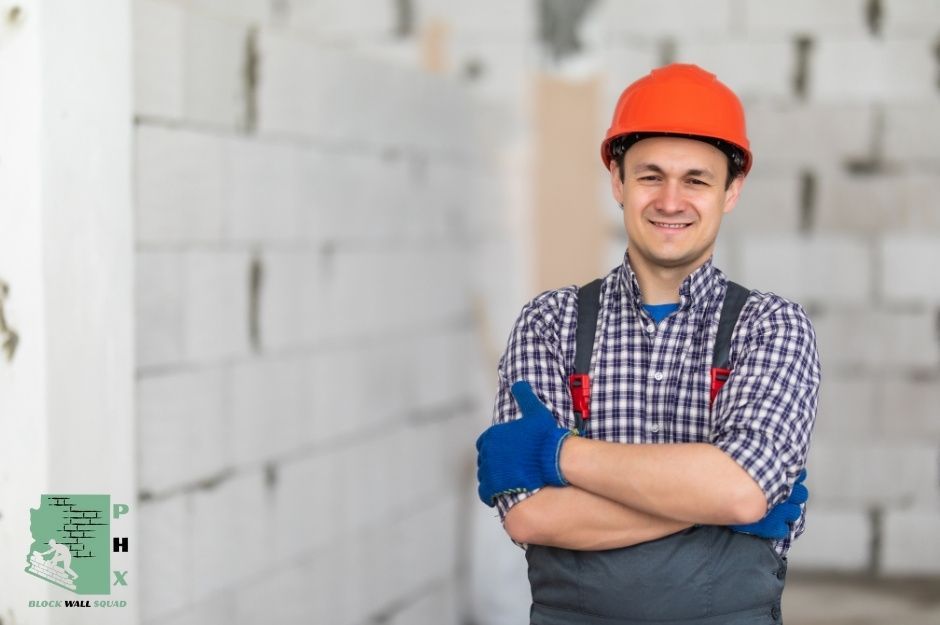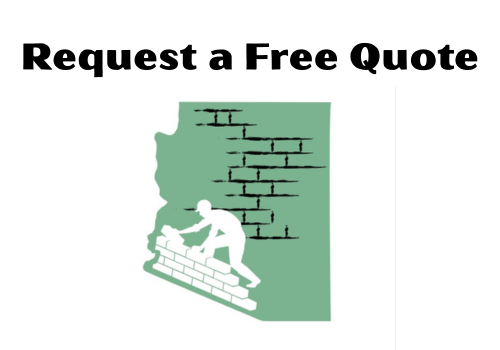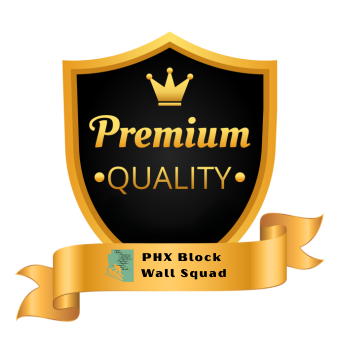Carefree Block Wall Repair
Block Wall Repair in Carefree, Arizona Crack & Lean Fix Specialists

Block wall issues can significantly impact your property's safety and appearance in Carefree, Arizona. Located in northeastern Maricopa County and covering 8.8 square miles of desert terrain, from simple cracks to severe structural problems, these concerns need prompt attention from qualified professionals who understand the unique challenges of desert construction.
At PHX Block Wall Squad, multiple experienced contractors in Carefree specialize in comprehensive block wall repairs, including crack remediation, stabilization of leaning walls, and water damage restoration.

PHX Block Wall Squad (CP -Carefree)

Your block wall repair needs might extend to retaining walls, which are crucial for property stability in Carefree's varied terrain. With the town situated near Black Mountain, which rises 1,000 feet above the valley floor to 3,398 feet elevation, proper retaining wall construction is essential for managing the sloped topography that characterizes much of the area. Professional contractors can assess structural integrity, repair deterioration, and reinforce these essential structures to prevent soil erosion and maintain your property's safety.
Block Wall Repair Services in Carefree, Arizona
Professional block wall repair services in Carefree address structural damage, cracks, leaning issues, and water-related deterioration through specialized techniques and expert craftsmanship. Given Carefree's hot semi-arid climate (Köppen BSh) with 141 afternoons annually reaching at least 90°F and temperature swings that can reach as low as 15°F, block walls face significant thermal expansion and contraction stresses.
Comprehensive Assessment and Diagnosis
Your block wall contractor will conduct a thorough inspection to identify all damage points and underlying causes. They use specialized equipment to measure wall stability, foundation settling, and structural integrity.
The assessment includes checking for soil conditions, drainage patterns, and potential underground issues affecting your wall's performance. In Carefree's desert environment, contractors must also evaluate how the area's annual 12.58 inches of precipitation, which is 70% more than Phoenix receives due to proximity to Arizona's central mountains, affects drainage and soil stability around wall foundations.
Common signs requiring immediate attention:
- Visible cracks larger than 1/8 inch
- Bulging or bowing sections
- Separated blocks or missing mortar
- Foundation displacement
Crack Repair Techniques
Certified contractors employ various methods based on crack severity and location. Small hairline cracks often need simple patching with specialized masonry epoxy.
For moderate cracks, contractors inject epoxy or urethane foam to stabilize the wall structure. This prevents water infiltration and further deterioration. During Carefree's monsoon season (typically July-August when the area receives 1.27-1.30 inches monthly), proper crack sealing becomes critical as heavy rainfall can quickly worsen existing damage.
Large structural cracks require partial rebuilding of affected sections. Your contractor will match existing block patterns and mortar colors for seamless repair.
Leaning Wall Correction
Leaning block walls often result from soil pressure or foundation issues. Contractors first stabilize the ground using proper drainage solutions and soil compaction. The freeze-thaw cycles that occur during Carefree's winter months, when temperatures can drop below freezing on 8.3 mornings annually, contribute to soil expansion and wall movement that requires specialized correction techniques.
Carbon fiber straps or steel braces can reinforce walls with minor lean angles. For severe cases, contractors may need to rebuild sections with proper footings and reinforcement.
The repair process includes:
- Soil stabilization
- Foundation reinforcement
- Wall straightening
- Structural support installation
Restoration After Water Damage
Water-damaged block walls require immediate attention to prevent further deterioration. Your contractor will first identify and correct the water source through proper drainage solutions.
Efflorescence removal and waterproof coating application protect against future moisture problems. Damaged blocks are replaced, and new mortar joints are sealed with water-resistant materials. Carefree's wettest month on record was January 1993 with 9.37 inches of rainfall, demonstrating how extreme weather events can cause significant water damage to improperly protected block walls.
Essential waterproofing steps include:
- Drainage correction
- Sealer application
- Mortar joint repair
- Installation of water barriers
Retaining Wall Repair Solutions
Professional retaining wall repair requires identifying structural issues, implementing proper reinforcement techniques, and ensuring adequate drainage to prevent future damage. In Carefree, where the terrain varies significantly due to the proximity to Black Mountain and the Sonoran Desert landscape, retaining walls are essential for managing elevation changes and preventing erosion on sloped properties.
Common Causes of Retaining Wall Failure
Water pressure buildup behind the wall creates excessive force that can cause bulging or leaning. Poor drainage systems often lead to soil saturation and increased hydrostatic pressure.
Improper construction, including inadequate foundation depth or incorrect backfill materials, weakens the wall's structural integrity.
Soil erosion beneath the foundation can create voids, leading to settlement and wall destabilization.
Freeze-thaw cycles in Carefree's winter months can cause concrete blocks to crack or separate at the joints. While snowfall is infrequent in Carefree, the last measurable snow occurred on February 22, 2019, accumulating 3-6 inches depending on elevation, creating conditions that can damage improperly constructed retaining walls.
Reinforcement and Stabilization Methods
Steel reinforcement bars (rebar) strengthen existing block walls by adding internal support. Installation requires precise drilling and proper anchoring techniques.
Carbon fiber strips provide external reinforcement for cracked or bowing sections without extensive demolition work.
Soil anchors extend deep into the ground behind the wall, creating additional stabilization points. These anchors connect to steel plates on the wall's face.
Helical tie-backs offer a less invasive alternative to traditional anchors, ideal for limited access areas. This method is particularly valuable in Carefree's developed areas near Scottsdale where space constraints and established landscaping around luxury properties require minimal disruption techniques.
Waterproofing and Drainage Upgrades
Drainage tiles installed at the wall's base redirect groundwater away from the foundation. These systems connect to proper discharge points to prevent water accumulation.
Weep holes placed strategically along the wall's base allow trapped water to escape, reducing hydrostatic pressure.
French drains with gravel backfill create a permeable barrier that filters and channels water away from the wall structure.
Waterproof membranes applied to the back face of block walls provide an additional barrier against moisture penetration. Given that Carefree receives about 5.3 inches more annual rainfall than Phoenix due to its location near Arizona's rain-catching central mountains, proper waterproofing becomes even more critical for long-term wall integrity.
Selecting the Right Block Wall Contractor
Choosing a qualified block wall contractor requires careful evaluation of their professional credentials, local experience, and service guarantees. Your investment in block wall repair demands a contractor who demonstrates expertise and reliability. In Carefree, where the town is served by Cave Creek Unified School District and residents value quality construction that complements the area's upscale desert community aesthetic, selecting an experienced local contractor is particularly important.
Qualities of a Professional Block Wall Contractor
Look for contractors with extensive experience in block wall repair and a proven track record in Carefree, Arizona. A professional contractor should offer a detailed inspection and provide clear documentation of all identified issues.
Request photos of their previous repair projects and ask about their specific experience with crack repairs, leaning walls, and water damage restoration. Contractors familiar with Carefree's unique challenges should understand how the town's elevation changes and desert climate affect different types of block wall construction.
Verify that the contractor uses high-quality materials and follows local building codes and standards.
Check online reviews and ask for references from recent clients in your area.
Locally Licensed and Insured Companies
Confirm the contractor holds valid Arizona state licensing for masonry and block wall repair work.
Request proof of liability insurance and worker's compensation coverage to protect your property and interests. Since Carefree is located along Arizona State Route 74 and Cave Creek Road, ensure your contractor has experience working in residential areas with established traffic patterns and accessibility considerations.
Essential Documentation:
- Current Arizona contractor's license
- General liability insurance certificate
- Local business permits
- Worker's compensation insurance
Comparing Quotes and Service Warranties
Request detailed written estimates from at least three block wall repair contractors.
Each quote should include:
- Specific repair methods
- Material costs
- Labor charges
- Project timeline
- Clean-up services
Review warranty terms carefully. A reputable contractor typically offers:
- 1-5 year workmanship guarantee
- Material warranties
- Written documentation of warranty terms
Avoid contractors who pressure you for immediate decisions or demand full payment upfront.
Maintaining Block and Retaining Walls for Longevity
Regular maintenance of block and retaining walls prevents costly repairs and extends their lifespan up to 50-80 years. Professional inspections combined with prompt attention to minor issues ensure structural integrity and protect your property investment. In Carefree's climate, where temperatures can swing from record lows of 15°F to highs of 118°F, thermal stress management through proper maintenance becomes crucial for wall longevity.
Inspection and Preventative Maintenance Tips
Check your walls every spring and fall for cracks, bulging, or leaning sections. Pay special attention after heavy rains or extreme temperature changes. Time your inspections to coincide with Carefree's seasonal weather patterns—particularly after the winter months when 8.3 mornings typically fall below freezing, and following summer heat waves when 63.4 afternoons exceed 100°F annually.
Clean your wall surfaces annually using a pressure washer on low settings to remove dirt and debris. Remove any vegetation growing within 12 inches of the wall base.
Key inspection points:
- Foundation settling or erosion
- Water drainage systems
- Cracking or spalling in blocks
- Joint deterioration
- Weep hole blockages
Ensure proper drainage by keeping gutters clean and maintaining grading that directs water away from the wall. This is especially important during Carefree's wettest months (January through March), when average precipitation reaches 1.60-1.80 inches per month.
Addressing Minor Issues Before They Escalate
Seal small cracks promptly using appropriate masonry sealants. Replace damaged blocks as soon as you notice them to prevent structural weakness.
Common early warning signs:
- Hairline cracks
- Missing mortar
- Efflorescence (white powder)
- Standing water near the base
Clear blocked drainage systems immediately to prevent water pressure buildup behind the wall.
Apply waterproof sealant every 3-5 years to protect against moisture damage and freeze-thaw cycles. Given Carefree's position in the Sonoran Desert where the landscape transitions between low desert and higher elevation terrain, proper sealing protects against both intense UV exposure and occasional moisture infiltration.
Keep soil levels 6 inches below the top of the wall to prevent overflow during rain events. This precaution is particularly important in Carefree, where rainfall patterns can be unpredictable but intense, as demonstrated by the record 26.20 inches that fell during the 1992-1993 rain year.
